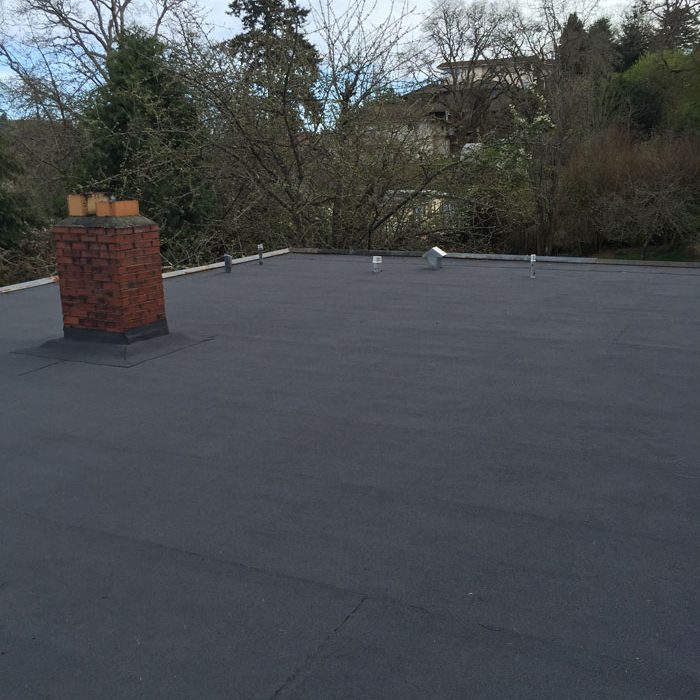Flat roofs may seem like a straightforward solution for sheltering our homes and buildings from the elements, but they often hide a not-so-simple secret: leaks. Yes, those mysterious drips and damp spots that have a knack for appearing at the most inconvenient times. In this article, we will discuss the things that cause leaks on flat roofs.
-
Age
The most common culprit behind leaks on flat roofs is the relentless march of time.
Just like all things in life, roofing materials also have their expiration date. Technological advances have blessed us with more durable roofing systems in recent decades, but older roofs, particularly those from the 1960s and 1980s, may have seen better days.
Back in the swinging ’60s, flat roofs were often constructed with a simple “pour and roll” system consisting of rag fibers smothered in bitumen. In the ’70s and ’80s, we got acquainted with polyester-based HT membranes like the 5e’s and 5b’s, which typically had a lifespan of around 20 years.
Fast forward to the ’90s elastomeric membranes, roofs came with a life expectancy of 30 years or more – over three times that of their 1960s counterparts.
So, if your flat roof boasts a birthdate from the bygone era of disco or even the neon ’80s, chances are those membranes are well past their sell-by date. With the aging process, these membranes become more fragile.
The once-effective UV ray-reflecting paint may have eroded, leading to splits and blisters. General wear and tear and those pesky freeze-thaw cycles can also hasten the breakdown.
You might consider short-term fixes like patching or overlays for smaller areas to remedy this. But if the underlying structure has succumbed to the ravages of time, the wisest path is to opt for a brand-new flat roof.
It’s the ultimate solution for restoring age-related leaks, ensuring your roof stays watertight for years.
-
Installation issues
When it comes to flat roofs, the quality of installation can make or break their watertight integrity. Roofing is a specialized skill; even the finest materials can succumb to leaks if not properly installed.
For instance, modified bitumen requires labor-intensive layering, torch-down methods pose fire risks, and cold-rolled technology demands roofing tar.
Rubber EPDM’s size can pose challenges, while air pockets in rolled-out roofing may lead to future leaks. Newer materials like TPO and PVC also require specialized expertise.
Hence, hiring qualified and accredited contractors is necessary to prevent installation issues. While cheap labor with limited skills can lead to costly mistakes, accredited contractors bring competence and experience.
They ensure a professional touch throughout the process. Qualified contractors also communicate openly with project managers and designers as they avoid shortcuts that might compromise the roof’s durability.
-
Poor drainage and pooling
Leaks on flat roofs often trace their origins to poor drainage and pooling. Trouble breeds when water lingers on a roof for more than 48 hours.
While pooling may not instantly lead to a leak, it gradually wears down roofing materials, exploiting any vulnerabilities.
In addition, pooling water also burdens your roof with extra weight, which can lead to potential structural harm.
To prevent this watery menace, proper installation is key. Flat roofs should never be entirely level; a slight slope of at least a quarter inch per foot is crucial to channel water toward drainage points.
There is also the need for clear paths for water flow, like roof drains, scuppers, gutters, or downspouts. Over time, these water paths will need regular maintenance to avoid blockage.
-
Loose collars or damaged flashing
Leaks on flat roofs often sneak in through vulnerable points like loose collars or damaged flashing. These components serve as protective barriers, keeping water at bay, especially around roof penetrations like vents, HVAC units, and pipes.
Rain collars, for instance, deflect water away from openings to prevent potential leaks. Made of metal, flashing guides water away from penetrations and safeguards against temperature-induced expansions and contractions in asphalt roofs.
Keeping an eye on these during regular roof inspections is vital. When hunting for leaks, the areas surrounding penetrations should be your first stop.
-
Blisters
Blisters on flat roofs are like warning signals of potential trouble brewing beneath the surface. They typically indicate the presence of water inside the roofing system by creating pressure that forces blisters to form as the water vapor tries to escape upwards.
Water can sneak into your roof through various avenues:
- If insulation or timber is damp during installation.
- If the roof isn’t adequately dried after a bout of rain during installation.
- Failures in the membrane, especially at joints and details where membrane sections are connected.
- Punctures and penetrations that aren’t correctly detailed and installed.
Blisters weaken the roof membrane and may fail because it’s not designed to stretch excessively. You should note that blisters can tug on nearby joints and cause them to fail, worsening the problem.
As your roof ages, it may also suffer from “bridging,” where the membrane shrinks, leading to stress on seams and flashings. The effect of bridging can be more pronounced in EPDM membranes.
Bridging and blistering can eventually result in cracks in the membrane which may eventually lead to a tear in the roof structure.
Blisters are your roof’s way of saying, “Help! I have a moisture problem.” So, you should ensure to address them quickly.
Conclusion
When it comes to safeguarding your flat roof, trust the experts at Shoreline Roofing. We offer top-notch roofing services that include installation, repairs, and inspections. Don’t leave the integrity of your roof to chance; contact us today to discover how we can ensure your flat roof stays leak-free and resilient for years to come.

